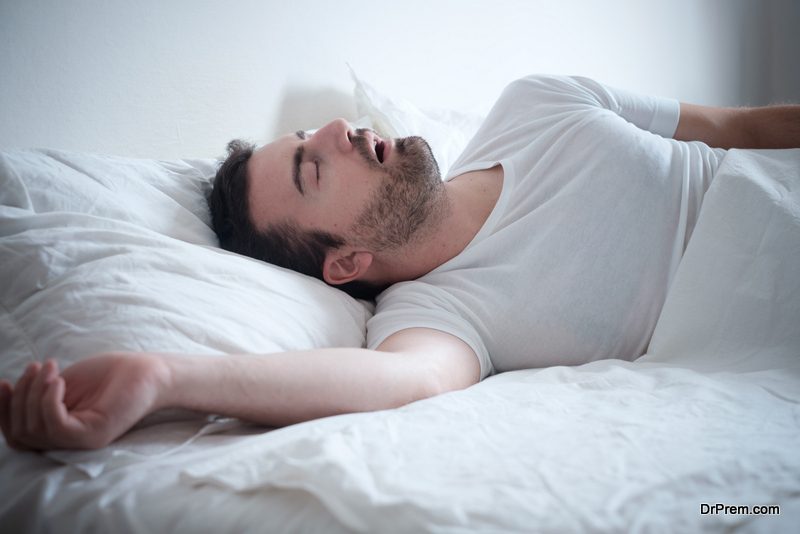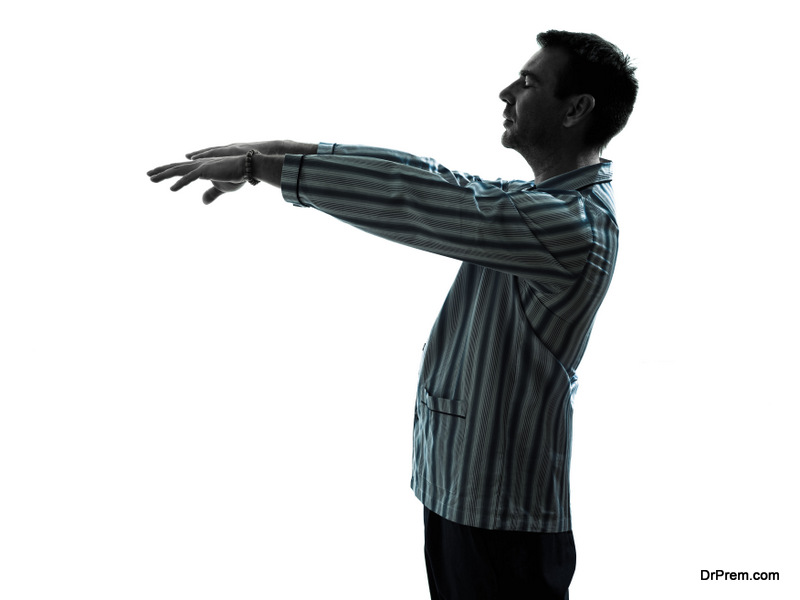There are a few things in life that people argue they don’t get enough of, and sleep tops the list (along with money). In fact, according to the CDC, 1 in 3 adults is not getting enough sleep. Without adequate rest, you’re at risk for countless health complications and are unable to perform daily tasks in an efficient manner. But for some people, lack of sleep isn’t just due to a busy schedule or late nights partying or watching Netflix. For some, a sleep disorder interferes with their lives and their ability to get quality rest. Here are warning signs of 5 common sleep disorders, as well as potential causes and treatment options.
1. Narcolepsy
 Narcolepsy is a very serious sleep disorder that affects approximately every 1 in 2,000 people, which equates to 200,000 Americans and 3 million people worldwide. Narcolepsy often goes untreated for sometime because the onset of the disorder resembles many other diseases. One of the primary symptoms of narcolepsy is extreme fatigue and excessive daytime sleepiness. Simple lack of sleep, restless or disturbed sleep, excessive stress, or poor diet can all attribute to daytime fatigue. But narcolepsy is a much more serious condition.
Narcolepsy is a very serious sleep disorder that affects approximately every 1 in 2,000 people, which equates to 200,000 Americans and 3 million people worldwide. Narcolepsy often goes untreated for sometime because the onset of the disorder resembles many other diseases. One of the primary symptoms of narcolepsy is extreme fatigue and excessive daytime sleepiness. Simple lack of sleep, restless or disturbed sleep, excessive stress, or poor diet can all attribute to daytime fatigue. But narcolepsy is a much more serious condition.
Symptoms quickly progress from simple sleepiness to hallucinations and cataplexy. Cataplexy in normal people occurs during your REM (rapid eye movement) cycle of sleep. In people with narcolepsy, it causes a sudden loss of muscle control, including the extremities and face. Cataplexy episodes generally occur following a moment of intense emotion, including laughing or crying. Cataplexy in narcolepsy patients is caused by the loss of hypocretin, a chemical in the brain that keeps your body and mind alert. Hypocretin also regulates a person’s awake and sleep cycles, which is why people with narcolepsy can’t differentiate between being awake and asleep. Lack of hypocretin makes it very difficult for narcolepsy patients to stay awake. They often walk around in a daze and state of confusion. There’s no known cause for narcolepsy other than the region of the brain where the hypocretin chemical is stored (known as the hypothalamus) is damaged or destroyed. Without this, people cannot maintain normal sleep habits.
There are treatment options available for treating narcolepsy and most include medications. A drug known as Xyrem (or sodium oxybate) can help treat cataplexy episodes, while also helping to control daytime sleepiness. You can also try different methods of combating daytime sleep including caffeine and medications that help you stay alert. You can buy adrafinil capsules here, which are proven to boost energy and increase both alertness and focus.
2. Sleep Apnea
 Sleep apnea is a very common sleep disorder affecting 22 million Americans. The most notable signs of sleep apnea include excessive snoring and daytime sleepiness. During sleep apnea, patients airways become obstructed, causing them to gasp for air and periodically stop breathing. This puts unnecessary stress on the heart, lungs, and brain. Sleep apnea is a very serious condition that gone untreated could result in additional health complications. Overweight people are at the greatest risk for sleep apnea. Your airway becomes blocked during sleep when the muscles in your throat relax, and your tongue falls to the back of your mouth and throat. This constricts airflow and makes it impossible to breathe naturally. This causes snoring and keeps you from sleeping. Most sleep apnea sufferers don’t realize they have the condition until a partner or roomate points out their snoring or gasping for breath. Sufferers will also feel extremely tired throughout the day, since they’re experiencing disrupted sleep.
Sleep apnea is a very common sleep disorder affecting 22 million Americans. The most notable signs of sleep apnea include excessive snoring and daytime sleepiness. During sleep apnea, patients airways become obstructed, causing them to gasp for air and periodically stop breathing. This puts unnecessary stress on the heart, lungs, and brain. Sleep apnea is a very serious condition that gone untreated could result in additional health complications. Overweight people are at the greatest risk for sleep apnea. Your airway becomes blocked during sleep when the muscles in your throat relax, and your tongue falls to the back of your mouth and throat. This constricts airflow and makes it impossible to breathe naturally. This causes snoring and keeps you from sleeping. Most sleep apnea sufferers don’t realize they have the condition until a partner or roomate points out their snoring or gasping for breath. Sufferers will also feel extremely tired throughout the day, since they’re experiencing disrupted sleep.
The best way to diagnose sleep apnea is with a sleep study. This determines how many periods of disturbed sleep you experience throughout the night. It tracks how many times you stop breathing and how low your oxygen levels drop. Once you’ve been diagnosed, your doctor will most likely recommend a sleep apnea machine, also known as a CPAP. A CPAP (constant positive airway pressure) machine uses pressurized air to keep your airways open and clear. This is done using a mask and hose system. While a CPAP can be somewhat uncomfortable to wear, most patients adjust within a few days or weeks. And the sleep you’ll experience will leave you feeling energized and well-rested, which is well-worth a few nights of discomfort.
3. Insomnia
 Insomnia poses the opposite issues as narcolepsy. Insomniacs have trouble going to sleep and staying asleep. While everyone experiences restless sleep, for insomniacs, lack of sleep is a chronic condition caused by several external factors. Some medications can cause insomnia, as well as biological factors, unhealthy sleep habits, and other medical and psychiatric conditions. It’s also believed that an imbalance in your sleep and awake cycles can also cause insomnia. Insomnia is characterized as any chronic lack of sleep or inability to fall asleep or stay asleep. This can vary greatly from person to person.
Insomnia poses the opposite issues as narcolepsy. Insomniacs have trouble going to sleep and staying asleep. While everyone experiences restless sleep, for insomniacs, lack of sleep is a chronic condition caused by several external factors. Some medications can cause insomnia, as well as biological factors, unhealthy sleep habits, and other medical and psychiatric conditions. It’s also believed that an imbalance in your sleep and awake cycles can also cause insomnia. Insomnia is characterized as any chronic lack of sleep or inability to fall asleep or stay asleep. This can vary greatly from person to person.
Some medical causes of insomnia include:
- Chronic pain
- Neurological disorders
- Asthma/Difficulty breathing
- Gastrointestinal issues
- Allergies
- Endocrine conditions
Some medications taken for the above conditions as well we thyroid disease, high blood pressure, and depression can also cause insomnia.
But not all causes of insomnia are physical or medical. Psychiatric conditions such as depression and anxiety can also interrupt sleep on a regular basis. These conditions affect your mood, hormones, and brain activity, making it difficult for your body and mind to enter a state of relaxation that welcomes sleep. What makes this condition even more complicated is that insomnia may increase or worsen depression symptoms. If you’re not sleeping well and have a history of psychiatric issues, it’s important to address them immediately to avoid any further complications.
Treating insomnia has a lot to do with adjusting your lifestyle and identifying the cause. Adopting a healthy sleep routine and healthy sleep habits can also improve insomnia symptoms. Things like going to bed at the same time and waking at the same time each day, creating a calming atmosphere for sleep, and avoiding certain food or drink before bed can improve the quality of your sleep. Medications and cognitive behavioral therapy can also offer relief to insomniacs.
4. Restless Leg Syndrome
 Restless leg syndrome is an uncomfortable condition that keeps people from falling asleep and staying asleep due to pain and discomfort in the legs. Restless leg syndrome (RLS) causes feelings of tugging, pulling, tingling, and pain in the legs, causing people to constantly move or adjust their position to get comfortable and find relief. This constant moving and adjusting gives the condition its name and keeps sufferers from falling into a deep sleep. Symptoms are often worse when you’re at rest or trying to sleep. During rest, your muscles are relaxed and you’re aware of the sensations.
Restless leg syndrome is an uncomfortable condition that keeps people from falling asleep and staying asleep due to pain and discomfort in the legs. Restless leg syndrome (RLS) causes feelings of tugging, pulling, tingling, and pain in the legs, causing people to constantly move or adjust their position to get comfortable and find relief. This constant moving and adjusting gives the condition its name and keeps sufferers from falling into a deep sleep. Symptoms are often worse when you’re at rest or trying to sleep. During rest, your muscles are relaxed and you’re aware of the sensations.
There is no known cause or cure for RLS, making it a very frustrating disorder. But there are things you can do. Your doctor might recommend reducing or eliminating coffee or alcohol from your diet. Both these beverages act as stimulants and can worsen RLS symptoms. Regular exercise increases blood flow to your muscles. Exercise also promotes the release of chemicals known as endorphins and dopamine. Endorphins promote relaxation and happiness, making sleep more attainable, whereas dopamine helps reduce pain. During an RLS episode, patients can try applying cold or cool compresses, use a heating pad, or take a warm bath. Some medications may worsen symptoms while others can help in extreme cases.
5. Sleepwalking
 While sleepwalking can be somewhat comical for those people watching, for the person experiencing it, the condition can be quite scary. And it’s actually a sign that you’re not sleeping well or enough. Only about 3.5% of the adult population (or 8.4 million people) suffers from sleepwalking but a shocking 30% have admitted to walking in their sleep at least once in their lifetime. Some sleepwalking episodes are triggered by severe illness, high fever, or are a side effect of medication.
While sleepwalking can be somewhat comical for those people watching, for the person experiencing it, the condition can be quite scary. And it’s actually a sign that you’re not sleeping well or enough. Only about 3.5% of the adult population (or 8.4 million people) suffers from sleepwalking but a shocking 30% have admitted to walking in their sleep at least once in their lifetime. Some sleepwalking episodes are triggered by severe illness, high fever, or are a side effect of medication.
It’s pretty easy to know if you’re sleepwalking. Most people eventually wake up during their episode and are often in a strange or uncommon place. Some people eat while sleepwalking or even go outdoors, making this disorder dangerous in some cases. Sleepwalkers may even hurt themselves or others during a serious episode. Children are at greater risk for sleepwalking, but it does affect adults as well. The deep sleep you experience is called NREM (non-rapid eye movement). It’s believed that when your body doesn’t transition properly from the NREM cycle to being awake, sleepwalking may occur.
While there’s no known cause for sleepwalking, you can take certain steps toward treating and preventing episodes. Most recommendations are associated with establishing healthy sleep patterns. Pay close attention to see if there’s a pattern in your sleepwalking episodes. Do they generally happen following a stressful day? Do you sleepwalk after hitting the gym at night? Identifying patterns can help you avoid these triggers in the future. Getting quality sleep can also help, so try developing a healthy sleep schedule. Reducing stress and increasing exercise can also improve sleep and help prevent sleepwalking.
To sum it up
Quality sleep is an important part of your life. Without it, you can’t perform of function adequately during the day. These 5 sleep disorders can interfere with regular, quality sleep, impacting your life in a variety of ways. Identifying your condition is the first step toward adopting a healthier way of life that involves a good night’s sleep.
Article Submitted By Community Writer




